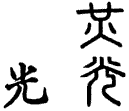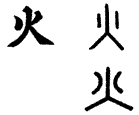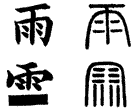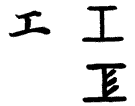
Gao4. To impeach, to indict; to do, with the mouth (kou3), what is done by the ox (niu2) with its horns; to gore. ... By extension, to tell of, to advise of, etc.
The Creation page is the first of five pages that attempt to relate
the
forms of Chinese characters to ideas from the Book of Genesis.
Here is Wieger's explanation, that it is built from 2 signs, "ox" and "mouth". It is clear that the use of the modern form on The Genesis Site has led to an impossible analysis, since the first stroke of the modern character, which they translate as "alive", is not part of the original.

Gao4. To impeach, to indict; to do, with the mouth (kou3),
what
is done by the ox (niu2) with its horns; to gore. ... By
extension, to tell of, to advise of, etc.
Wieger says that gao4 is phonetic in zao4. This fact, combined with the original meaning of "to arrive at, to reach", makes nonsense of the explanation on The Genesis Site.

Zao4. Primitive sense, to arrive at, to reach. By extension, to
construct,
to build, to create.
This is another case of mistaking a single element for a compound element, based on the modern form. Wieger says that the upper element is not "alive" plus "dust", but is zhi1, "a small plant ascending from the ground".

Xian1. To advance; to progress (zhi1) with ones (ren2)
feet.
A quick look show us that the "first" (yi1) element does not occur in either of the older forms.

Guang1. Light, luster. Primitively twenty (nian4) fires (huo3,
see next). The modern form represents a man (ren2) with fire (huo3);
probably a man carrying a torch.

Huo3. Fire. Ascending flames.

Yu3. ...An ancient form simply represents a shower of rain.
Oddly, Nelson and Broadberry no longer support this
interpretation. They now claim that it represents "God on the mountain
where the river of
life is represented by water descending". It's hard to tell what this
is
supposed to have to do with rain.

Gong1. It represents the ancient [carpenter's] square. By
extension, work, skill, labour, any ornament requiring skill. For, says
the Glose (the
Shou1 Wen2), the square gives the shape to all things; it forms
the
right angle that forms the squares, that form the circles, etc. In an
ancient
form, the three slanted lines represent the parallel lines traced with
the
square.

Wu2. The work (gong1) of witches (cong2);
magic, incantations.
Two witches who dance to obtain rain.
![]()
Ling2. Noise of voices; from three mouths. [Wieger says that the
two
following are not derived from this, but I suspect that the next has it
for
a phonetic element, rather than representing rain drops, as Wieger
says.
However, Karlgren does agree with Wieger.]

Ling2. Falling of rain in big drops. Formerly, it made a
phonetic series,
in which is now written the compound

Ling2. To offer to heaven jade (at the bottom of the first version) or certain dances (at the bottom of the second version), in order to get rain. It was the first thing asked from the magicians and sorcerers, by the people whose life depended upon rain. By extension, spiritual, mysterious, supernatural power or effect, transcendent, marvellous.
The Garden of Eden The Fall The Flood The Tower of Babel
Back to the Chinese Characters and Genesis Home Page
![]() Back to RaccoonBend.com Home
Page
Back to RaccoonBend.com Home
Page